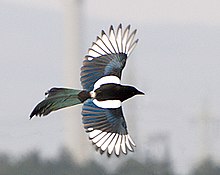Eurasian magpie
![]()
The title of this article is ambiguous. For other meanings, see Magpie (disambiguation).
The magpie (Pica pica) is a species of bird in the corvid family. It inhabits large parts of Europe and Asia as well as northern North Africa. In Europe, it is especially common in settled areas. Due to its characteristic black and white plumage with the strikingly long tail feathers, it is unmistakable even for the ornithological layman.
The magpie is one of the most intelligent birds, and is believed to be one of the most intelligent non-human animals around. Relative to its size, the magpie's caudolateral nidopallium is about the same size as the brains of chimpanzees, gorillas, orangutans and humans. The magpie is the only known bird to pass the mirror test, along with very few other non-bird species.
In Germanic mythology, the magpie was both the messenger of the gods and the bird of Hel, the goddess of death, so that in Europe it acquired the reputation of being the harbinger of disaster. As a "thieving" magpie, it was also unpopular in the Middle Ages as a witch beast and gallows bird. In contrast, in Asia it is traditionally considered a good luck charm, and the North American Hudsonian magpie (Pica hudsonia), which has long been considered a subspecies, is a spirit being among the Indians that is friends with humans.
Description
The basic colors of magpies of the nominal form are black and white. The tail is stepped and often as long as the rest of the body, but in any case longer than the wings. The belly, flanks and shoulders are white, and the hand wings are also predominantly white. The rest of the plumage is black with a metallic sheen. The tail feathers and the outer plumes of the wing feathers shimmer metallic green, blue or purple at close range, depending on the light conditions. In spring, the colors become duller and less iridescent. They are almost completely lost on the outer plumes of the hand feathers. Birds several years old, especially the males, are most iridescent shortly after molting. Male and female magpies do not differ externally, but males are slightly heavier than females, averaging 233 g (203 g). Magpies can reach a body length of about 46 cm, the wingspan is about 48-53 cm.
Young magpies, which have a bright red throat, are colored almost the same as adults, the differences are very small. The tail is lacklustre and shorter. The outer shoulder feathers are often not pure white, but somewhat gray. The white areas on the inner plumes of the outer handwings do not extend as far to the feather tip as in adult magpies. The arm wings show blue sheen only in the central area. The outermost arm wing almost always bears a white patch, sometimes also the second or the third feather following it.
Their molt annual magpies begin a little earlier than perennial birds. They change the whole plumage. In Europe, annual and perennial birds start moulting in June, fledged birds in July at the earliest, at the latest at the end of August.
The locomotion of the magpie on the ground is mostly hopping. However, it is also able to walk. The magpie moves very skillfully in the branches of trees. It has an undulating fluttering flight.

Magpie in flight
Voice
The magpie most frequently lets the "Schackern" or "Schäckern" be heard. It consists of more or less quickly successive call series with slightly croaking "schäck-schäck-schäck". The "Schäckern" is a warning and alarm call and serves to defend the territory. Non-breeding magpies use it only when danger threatens. The excitement of the animals is especially great when the chaffing is fast and choppy. Thus, they face danger when they chatter slowly, but flee when they call quickly.
To consolidate the partnership, couples let you hear a quiet chatter. This varies greatly in time and individually. It can be rhythmic as well as arhythmic. It often includes soft trills and high-pitched whistling. Individual birds imitate other animals. Mostly, however, the song consists of a gurgling, ventriloquistic chatter with whistling sounds.
To mark their territory, pairs make a call that sounds like "kia", "kjää" or "kik". They often show themselves in the middle of the territory on the highest branches of a tree.
Nestlings beg with a high-pitched screeching "twiit". Three to four-week-old fledglings announce themselves to the adults with a two-syllable call. It sounds like "jschiejäk", "tschjuk" or "tschjuk-juk". The contact call of the female resembles the site call of the young birds.
Often the magpie also gives a long drawn "tschark" "tschirk" "tschirrl" or "tschara" from itself. Depending on the intonation (soft, hard, long, short) this call has different meanings. In addition, the magpie can also make nasal and stretched sounds such as "gräh" heard.
Urs N. Glutz von Blotzheim does not exclude the fact that free-living magpies sometimes imitate foreign bird species, but this is neither the rule nor completely certain; Glutz von Blotzheim formulates vaguely: "Some individuals also incorporate vocalizations that sound like imitations (e.g. starling, song thrush, grasshopper chirps)".
Search within the encyclopedia